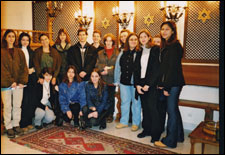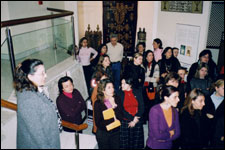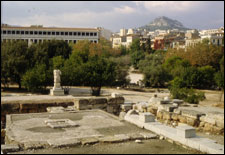he
 The most important
sights of Jewish interest in
Athens The most important
sights of Jewish interest in
Athens |
About the Athens
Jewish
Museum

OPENING HOURS AND ADMISSION FEES:
Opening hours
Monday to Friday: 9.00-14.30
Sundays: 10.00-14.00
Saturdays: closed
Admission fees: Adults 5 Euros,
students 3 Euros
Guided tour fees for groups
10-20 people: 45 €
20-35 people: 60 €
DIRECTIONS:
The Jewish Museum of Greece is at 39, Nikis
street, in the centre of Athens, not far from
the Acropolis and other sites of interest.
Its 19th century renovated building
is easy to find, as Nikis st. runs parallel to
the very busy Filellinon st. and Amalias Avenue,
while being quite close to the Syntagma Metro
Station.
How to get there:
-
 Using
the Metro Using
the Metro
By far the easiest way to get
there. Get off at Syntagma Station. Once
in Syntagma Square, look for Mitropoleos
st. (in the lower half of the square, at
its SW corner). The first street
branching off the left of Mitropoleos
street is Nikis. Number 39 is a three
minute walk from there.
-
By Bus / Trolley Bus
You may use several buses or
trolley buses depending on where your
starting point is. Ask for those which
stop at Syntagma (and then proceed as
above) or at Filellinon st. There is one
bus stop and one trolley-bus stop in
that street, next to each other, across
what is called the “Russian Church” (no,
it doesn’t look Russian at all). Once
off the bus, turn right into a small,
pedestrian alley (Kydathinaion) and then
right again; the Museum will be on your
right-hand side.
-
By Tram
The museum is conveniently close to the
T1 Tram Line, namely Zappeio-N. Faliro.
Get off at Syntagma, turn your back to
the National Gardens and cross the busy
Amalias Avenue, then, its parallel
Filellinon st., and walk on to the next
parallel street, which is Nikis. The
museum should now be on your left.
-
On foot, after exploring Plaka
or Monastiraki
Once in Plaka or Monastiraki,
you cannot miss Adrianou street, easily
recognised by the dozens of souvenir
shops and throngs of tourists. Look for
Kydathinaion street, which branches off
it. With your back to Akropolis, go down
Kydathinaion street, until it intersects
with Nikis street, about 4 minutes away.
The Museum should be across the street,
on your left.
History of the Museum
 The
idea of building a Jewish Museum of Greece was first
conceived in the 1970’s by members of the Jewish
Community of Athens, who offered every kind of
assistance towards the realisation of this dream.
The Museum was first established in 1977 and housed
in a small room next to the city’s synagogue. It
housed objects salvaged from WW II, whether
artefacts, documents and manuscripts of the 19th
and 20th centuries, or the jewellery of
the Jews of Thrace that had been seized by the
Bulgarians in 1943. The latter had been returned to
the Greek government after the abdication of the
Bulgarian king and the establishment of a communist
regime in the country. The
idea of building a Jewish Museum of Greece was first
conceived in the 1970’s by members of the Jewish
Community of Athens, who offered every kind of
assistance towards the realisation of this dream.
The Museum was first established in 1977 and housed
in a small room next to the city’s synagogue. It
housed objects salvaged from WW II, whether
artefacts, documents and manuscripts of the 19th
and 20th centuries, or the jewellery of
the Jews of Thrace that had been seized by the
Bulgarians in 1943. The latter had been returned to
the Greek government after the abdication of the
Bulgarian king and the establishment of a communist
regime in the country.
The following years saw a thorough and careful
collection of material from all the communities of
Greece, under the inspired guidance of Nikos
Stavroulakis, director of the Museum until 1993. The
collection expanded with rare books and
publications, textiles, jewellery, domestic and
religious artifacts, thanks to the interest of
several individuals.
The Museum soon began to attract the attention of
many visitors, researchers and donors. In 1981, the
Association of American Friends was founded,
followed, a little later, by the Association of
Friends of the Jewish Museum of Greece, with members
of the Jewish Communities of Athens and
Thessaloniki.
As the Museum’s collection grew and its activities
expanded, it soon outgrew its first premises and new
ones had to be found. In 1984, it moved to a rented
space occupying the 3rd floor of 36,
Amalias Avenue. The exhibition was reorganised into
thematic units covering the interests of its various
visitors. After years of efforts, the Museum
acquired its legal status in 1989, as a non-profit
foundation with a seven-member Board of Directors.
 In
the following years the Museum’s activities
expanded; they involved both the research and study
of the Greek Jews - in collaboration with other
foundations and researchers from Greece and abroad -
and publishing. At the same time, its collection was
being continuously enriched with new acquisitions
from all over Greece, greatly exceeding all
expectations. The increasing needs of the Museum for
more space, together with the dream of sometime
having its own premises, led to the purchase of a 19th
century neoclassical building, with the support of
its Friends in Greece and abroad, the Jewish
Community of Thessaloniki and the Central Board of
Jewish Communities in Greece. In
the following years the Museum’s activities
expanded; they involved both the research and study
of the Greek Jews - in collaboration with other
foundations and researchers from Greece and abroad -
and publishing. At the same time, its collection was
being continuously enriched with new acquisitions
from all over Greece, greatly exceeding all
expectations. The increasing needs of the Museum for
more space, together with the dream of sometime
having its own premises, led to the purchase of a 19th
century neoclassical building, with the support of
its Friends in Greece and abroad, the Jewish
Community of Thessaloniki and the Central Board of
Jewish Communities in Greece.
With substantial financial support from the Greek
Ministry of Culture and the Associations of its
Friends, the old building was renovated and, in late
1997, twenty years after it first opened its doors
to the public, the Museum moved to 39 Nikis street,
its new address in the centre of Athens.
On March 10th, 1998, the new building of
the JMG was inaugurated and a new area begun for the
Museum. In the following years it developed
significantly and extended all its activities, and
especially the educational ones. Also, it improved
its visitors services and conducted thorough
research efforts, the results of which were
communicated through several temporary exhibitions
and special publications. Contact and communication
with the public and international relations and
activities of the JMG, signal an extensive social
and scientific information and influence exchange.
The J.M.G. Collections
 The
Museum’s collections include more than eight
thousand original artifacts, testifying to more than
23 centuries of Jewish presence in Greece. The
Museum’s collections include more than eight
thousand original artifacts, testifying to more than
23 centuries of Jewish presence in Greece.
Besides a few objects which Asher Moissis, president
of the Jewish Community of Athens, had collected
after the war, the core of the initial collection
was made up of items that had been returned to
Greece by the Bulgarian government, after the
establishment of a communist regime in that country.
These included personal effects, jewellery, domestic
items, synagogual objects and documents, which
belonged to the Jews of Eastern Macedonia and Thrace
and were confiscated after 1941, when the area fell
in the Bulgarian zone of occupation. The confiscated
items had been meticulously recorded and became the
first significant body of artifacts of the
collection.
This core material kept multiplying, mainly through
the donations of individuals and communities,
initially from the area of Thessaly, the island of
Rhodes and the city of Ioannina. Besides rare 17th -
19th century books and publications, a
significant number of ritual textiles was assembled,
during the years 1977-1982. Most of them date from
the Ottoman times (14th-19th
centuries), and soon became one of the Museum’s main
attractions, for both visitors and researchers. In
1984 the Jewish Community of Patras was dissolved
for lack of members and the interior of its
synagogue, along with its textiles and ritual
objects was bequeathed to the Museum. These
religious artifacts are extremely significant,
invaluable and irreplaceable, since they come, for
the most part, from synagogues and communities,
which no longer exist.
 After
these early acquisitions, began the organisation of
the artifacts into categories: ritual objects,
domestic and personal items, and Holocaust
artifacts, documents, and information material. More
donations from individuals and communities from both
Greece and abroad continued to pour in, further
enriching the collection. The Museum’s relocation to
its new premises (1998) brought a renewal of public
interest and more donations followed. After
these early acquisitions, began the organisation of
the artifacts into categories: ritual objects,
domestic and personal items, and Holocaust
artifacts, documents, and information material. More
donations from individuals and communities from both
Greece and abroad continued to pour in, further
enriching the collection. The Museum’s relocation to
its new premises (1998) brought a renewal of public
interest and more donations followed.
In general, the Museum has been receiving an average
of 250-300 new artifacts every year, since the year
2000. Its unique collections, which are continuously
being expanded, document more than four centuries of
Jewish life in Greece, considering that the oldest
textiles and antenuptial contracts date from the 16th
century C.E.
For more
information about Athens Jewish museums and
Community please visit
www.jewishmuseum.gr
PRIVATE TOURS WE SUGGEST:

All Athens private tours
|
Athens Highlights
|
Best of Athens
|
Cape Sounion |
Athens and Cape Sounion
|
|
Ancient Corinth
and the Canal
|Athens and Corinth Canal |
Ancient Delphi |
Notes:
These are the tours that we suggest, but you can
customize your itinerary the way you and your
Family feels more enjoyable and comfortable.
We can accommodate from one person to a large
group, we specialize in personal and Private
tour in Greece and the Greek Islands.
In most of the tours in Greece, sport type shoes
are recommended. |



 Sephardic
Synagogue Beth Shalom - 5
Melidoni st., Thission.
Sephardic
Synagogue Beth Shalom - 5
Melidoni st., Thission.

 Using
the Metro
Using
the Metro  In
the following years the Museum’s activities
expanded; they involved both the research and study
of the Greek Jews - in collaboration with other
foundations and researchers from Greece and abroad -
and publishing. At the same time, its collection was
being continuously enriched with new acquisitions
from all over Greece, greatly exceeding all
expectations. The increasing needs of the Museum for
more space, together with the dream of sometime
having its own premises, led to the purchase of a 19th
century neoclassical building, with the support of
its Friends in Greece and abroad, the Jewish
Community of Thessaloniki and the Central Board of
Jewish Communities in Greece.
In
the following years the Museum’s activities
expanded; they involved both the research and study
of the Greek Jews - in collaboration with other
foundations and researchers from Greece and abroad -
and publishing. At the same time, its collection was
being continuously enriched with new acquisitions
from all over Greece, greatly exceeding all
expectations. The increasing needs of the Museum for
more space, together with the dream of sometime
having its own premises, led to the purchase of a 19th
century neoclassical building, with the support of
its Friends in Greece and abroad, the Jewish
Community of Thessaloniki and the Central Board of
Jewish Communities in Greece.  The
Museum’s collections include more than eight
thousand original artifacts, testifying to more than
23 centuries of Jewish presence in Greece.
The
Museum’s collections include more than eight
thousand original artifacts, testifying to more than
23 centuries of Jewish presence in Greece. After
these early acquisitions, began the organisation of
the artifacts into categories: ritual objects,
domestic and personal items, and Holocaust
artifacts, documents, and information material. More
donations from individuals and communities from both
Greece and abroad continued to pour in, further
enriching the collection. The Museum’s relocation to
its new premises (1998) brought a renewal of public
interest and more donations followed.
After
these early acquisitions, began the organisation of
the artifacts into categories: ritual objects,
domestic and personal items, and Holocaust
artifacts, documents, and information material. More
donations from individuals and communities from both
Greece and abroad continued to pour in, further
enriching the collection. The Museum’s relocation to
its new premises (1998) brought a renewal of public
interest and more donations followed.